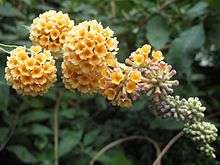Buddleja × weyeriana
Buddleja × weyeriana is one of the more remarkable Buddleja hybrids, the first crossing of an Asiatic species (B. davidii) with a South American (B. globosa). The hybrid was raised during the First World War by the eponymous Major William van de Weyer at his home, Smedmore House, at Corfe Castle, England. Van de Weyer was hoping to achieve an inflorescence the size of davidii with the colour of globosa, but met with only limited success.[1][2][3]
| Buddleja × weyeriana | |
|---|---|
 | |
| Origin | van de Weyer, Smedmore House, Corfe Castle, Dorset, UK. |
Description
The F1 progeny of × weyeriana was a disappointment, the inflorescences small and the colours drab. Van de Weyer rightly deduced the colour was a function of a recessive trait, and reputedly crossed the F1 plants to raise the superior F2 cultivars 'Golden Glow' and 'Moonlight', although both retained vestiges of the lilac colouring of davidii. However, Moore considered it more likely the cultivars arose from backcrossing the F1 hybrids with B. globosa.[4] The shrub's nectar is relatively complex, comprising three constituents in almost equal proportions: sucrose, fructose, and glucose, whereas the nectar of the common Buddleja davidii is almost exclusively sucrose.[5]
It was not until half a century later that the colour objective was realized, when a Dutch nursery cloned a pure orange-yellow sport of 'Golden Glow' to produce 'Sungold'.[2] An inflorescence the size of davidii with this desired colour remains (2014) elusive. Ploidy: 2n = 76.[6]
Cultivation
Buddleja × weyeriana 'Golden Glow' is the original plant of van de Weyer[1] exhibited in 1920. A specimen is grown as part of the NCCPG national collection held by the Longstock Park Nursery.[7] together with the cultvars 'Sungold', 'Moonlight', and Buddleja × weyeriana 'Variegata'. The authenticity of the other cultivars remains a matter contention.
Cultivars
At least nine cultivars have been raised, nearly all in Europe:
|
|
References
- Weyer, van de, W. (1920) Buddleja weyeriana. Gardeners' Chronicle ser. 3, 68: 181. 1920.
- Bean, W. J. (1980). Trees and shrubs hardy in the British Isles. Vol.1. 8th edition. Murray, UK.
- Stuart, D. (2006). Buddlejas. RHS Plant Collector Guide. Timber Press, Oregon. ISBN 978-0-88192-688-0
- Moore, R. J. (1960). Cytotaxonomic notes on Buddleia. L. Am. J. Bot. 47, 6, p. 511-517. 1960.
- Percival, M. (1961). Types of nectar in angiosperms. New Phytol. 60: 235-281. 1965. Floral biology. Pergamon Press, London.
- Norman, E. M. (2000). Buddlejaceae. Flora Neotropica 81. New York Botanical Garden, USA
- Moore, P. (2012). Buddleja List 2011-2012 Longstock Park Nursery. Longstock Park Nursery, UK.